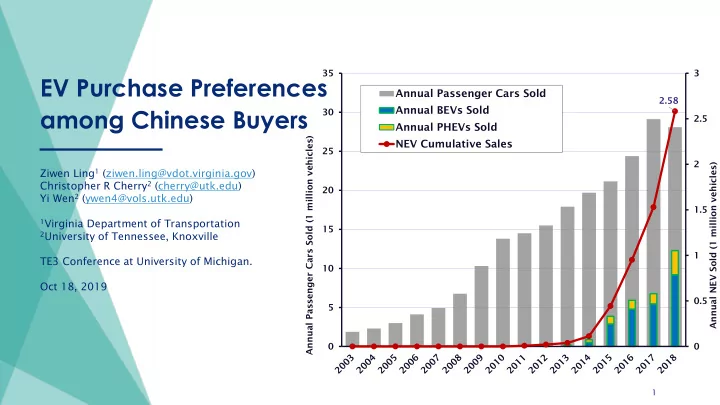

35 3 EV Purchase Preferences Annual Passenger Cars Sold 2.58 Annual BEVs Sold among Chinese Buyers 30 2.5 Annual PHEVs Sold Annual Passenger Cars Sold (1 million vehicles) NEV Cumulative Sales 25 2 Annual NEV Sold (1 million vehicles) Ziwen Ling 1 (ziwen.ling@vdot.virginia.gov) Christopher R Cherry 2 (cherry@utk.edu) 20 Yi Wen 2 (ywen4@vols.utk.edu) 1.5 1 Virginia Department of Transportation 15 2 University of Tennessee, Knoxville 1 TE3 Conference at University of Michigan. 10 Oct 18, 2019 0.5 5 0 0 1
1. China has sold 2.58 million EVs since 2003. 2. In 2018, China sells close to half of the EVs in the Background world. 3. Nationwide, China is committed to reduce its carbon intensity of the GDP by 60-65% by 2030 from 2015’s values. 4. The country is shifting towards electric buses and electric taxis rapidly. 5. Purchase subsidies are available, EVs are not Electric Taxis in Shenzhen, China restricted to license plate registration and traffic (Image Source: Shenzhen Shopper) controls in some cities, public charging stations are being built massively. 2
1. Survey of 1216 people in Beijing, China in 2015 1. Beijing is the capitol city of China 2. Beijing has well-known air pollution issues Methodology 2. Collected data on 1. Demographic information 2. Understanding of CVs, PHEVs, BEVs and e-bikes 3. Household vehicle purchase history and future plan 3. The sample is relatively representative of the population in Beijing. 4. Statistical analysis models were applied to understand what factors contribute to a higher chance of EV (PHEV and BEV) purchase. Smog Pollution in Beijing, China (Image Source: The Washington Post) 3
Positive Contributors 1. (+) Male (PHEVs and BEVs) 2. (+) Higher household income (PHEVs and BEVs) 3. (+) Number of e-bikes in the household (PHEVs) Findings 4. (+) Prior experience with driving or riding EVs (BEVs) Negative Contributors 5. (-) Pre-existing inclination towards CV (PHEVs) 6. (-) Planning to have a driver’s license in the next 3 years (PHEVs) 7. (-) Longer ownership of first motorized vehicle (PHEVs) 8. (-) Already having a driver’s license (BEVs) 9. (-) Higher purchase budget (BEVs) Preferred EV Policies 10.(+) Purchase subsidies, charging stations (50%) 11.(+) Free battery charging, license plate registration waivers (30%) 4
1. More direct monetary benefits 2. More public charging stations Policy Implications 3. More EV experience activities 1. Test drive 2. Test ride, ride-hailing (Uber/Lyft) 3. EV car share/rental 4. Target on mid-level income and below markets 5. Provide diverse EV options for high-end customers EV Ride-hailing Services in China 6. Attract new and future drivers (Image Source: Cheyun.com) 5
1. The soil of EV development in China 1. More political support 2. Level 2 charging is the standard (220V AC Outlet in China) 3. License plate registration and traffic control waivers Discussion Points 4. Familiarity with electrified transportation (e-bikes) 2. EVs are also vehicles by nature which consume roadway capacity, parking infrastructure, and energy. The promotion of EVs may lead to more congestion. 3. How can we make sure that EV friendly policies are switching drivers from regular vehicles to EVs, but not non-drivers from other modes to driving. 4. Smaller EVs (mini-EVs) and EV car-sharing may be promoted to reduce impacts of vehicles while keeping Mini EVs are gaining popularity in China the benefits of EVs. (Image Source: The Wall Street Journal) 6
Recommend
More recommend